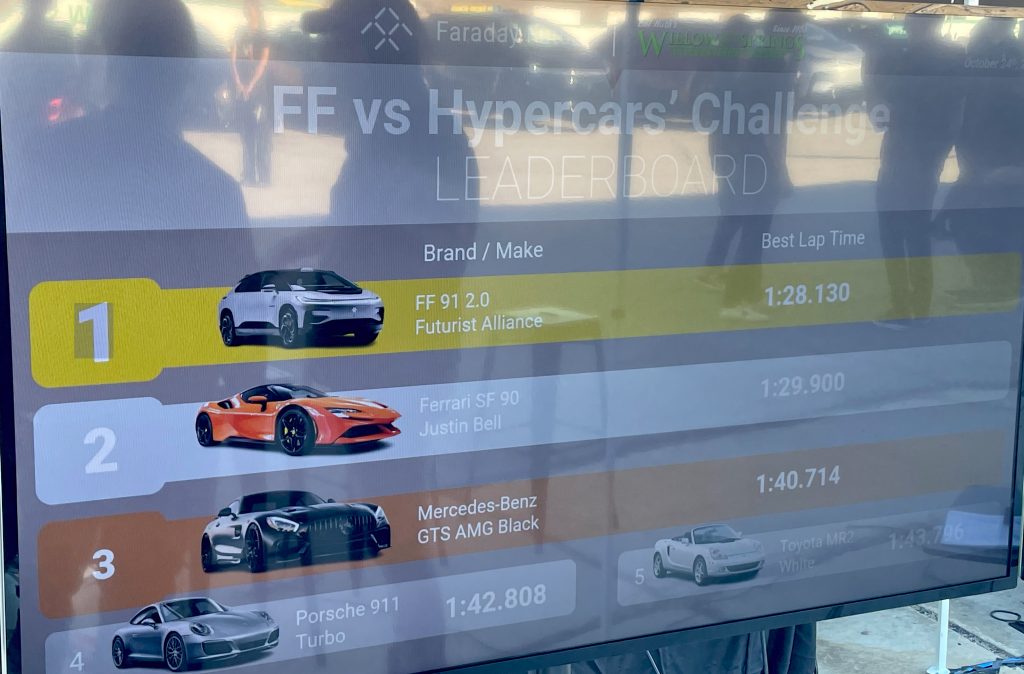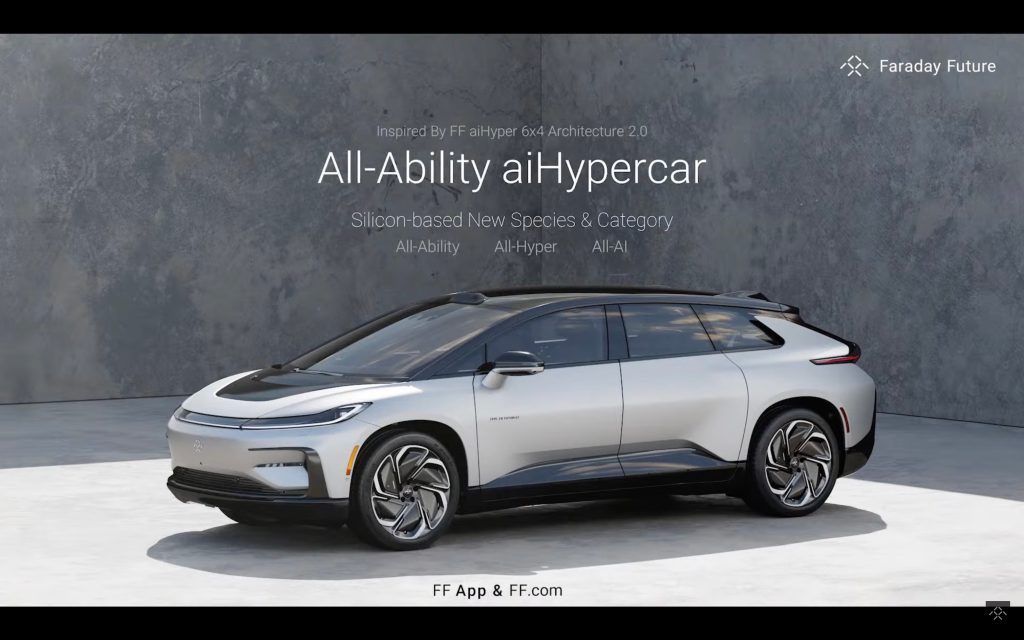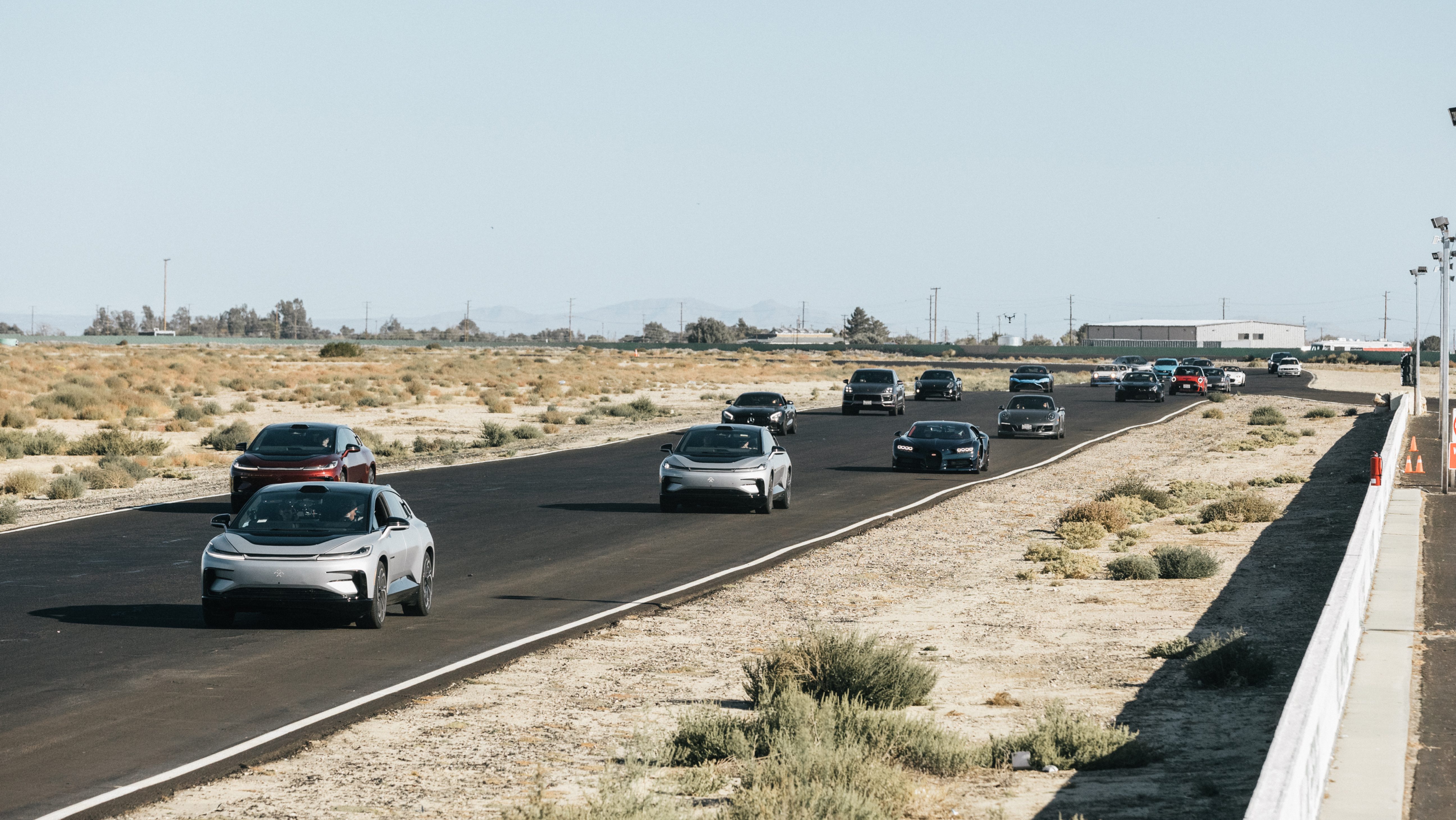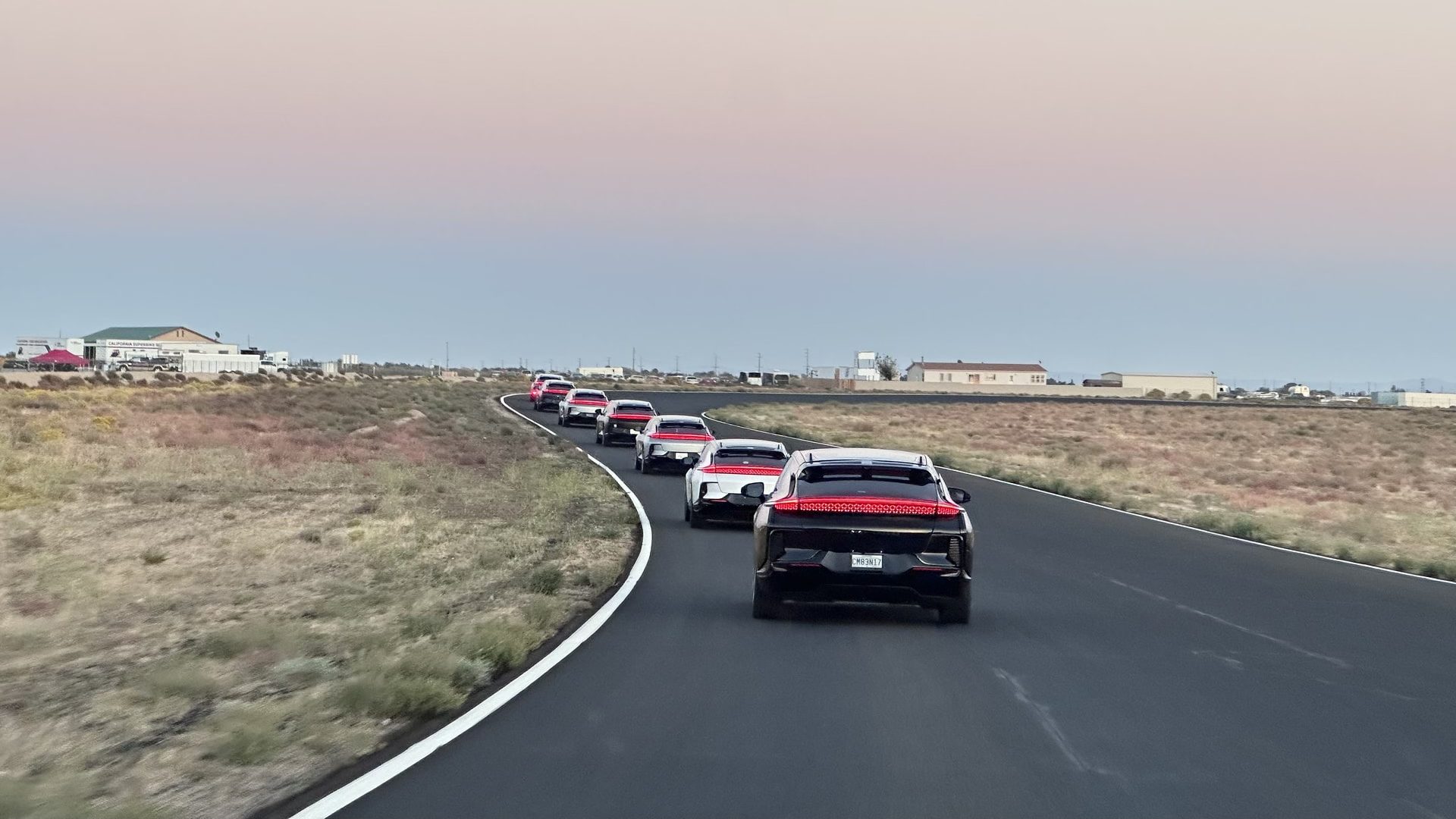The Faraday Future FF91 actually exists, and I was the first media to drive it


Faraday Future, the oft-delayed electric vehicle startup, has finally brought the FF91 to market, and we were the first media to drive a real production-spec version of the car, around Willow Springs raceway no less.
Faraday invited us to Willow Springs to attend its latest “delivery co-creation day,” where race car driver and Le Mans class winner Justin Bell took delivery of his FF91 2.0 Futurist Alliance limited-edition vehicle. This is the seventh car the company has delivered since the official start of production in March and the start of shipping in May. Faraday is showing a video on its website to recap the events of the day, which should be live as this article is published.
Willow Springs was a fitting location since the event was also the launch of Faraday’s “Racetrack Conqueror Plan,” where the point is to visit racetracks around the world to set track records with its electric car.
Bell and his father, Derek (a multiple Le Mans winner and ex-F1 driver who also has an FF91 on order), say they’re going to work on developing a racing package for the FF91, which will help it on its way to these records. Faraday also plans to engage with other racing drivers in the future – Romain Dumas was one example given.

Faraday also invited other VIPs, including various supercar owners, to come out and challenge the FF91 on the track. A Bugatti Chiron, a Ferrari SF 90 PHEV, a Mercedes GTS AMG Black, and others were in attendance. Faraday did manage to set a record on the day and beat the various other cars at the track.
The FF91 set a lap time of 1:28.13, which beat out the Lamborghini Urus for the fastest lap by an SUV (gas or electric) by more than two seconds. According to fastestlaps.com, that puts the FF91 just behind the Porsche 911 GT3, McLaren 570S and Tesla Model S Plaid by less than a second each and just ahead of the BMW M4 CSL and the 760hp supercharged V-8 Shelby Mustang GT500.
And then, five years after Faraday’s initial production intent and with several attempts at restructuring the company and finding contingent funding inbetween, we finally got a chance to hop behind the wheel.
While Faraday has offered some media drives before, those were in prototype vehicles, whereas this is the first time in a real production vehicle and the first time on a track. We drove production VIN #1, the car belonging to Faraday Future’s founder, Yueting “YT” Jia.
First drive: 1,050 mind-blowing, silent horsepower
This was definitely just a first drive – we didn’t get any street time with the car, just a few laps on the track and a little time sitting in it and messing around with the interface.
But the track time meant we could really get a sense of what the FF91’s 1,050 horsepower (yes, you read that right, one thousand and fifty horsepower) can really do.
On the front straight, it started pulling, and then it kept pulling, and then it kept pulling. It just never stopped pulling. I got up to about 145mph (of its electronically limited 155mph), and it didn’t feel like it was petering out.
And I felt like I was taking it easy. Even at that high speed, the car showed no sign of drama. It was quiet and smooth inside, and there weren’t any theatrics on the way to achieving a faster land speed than most people will ever see.
And even better, in my opinion, was the complete lack of drama on the exterior of the car. The car was not screaming loudly as it blasted by the grandstands. (In fact, it was perhaps easier to hear the motorcycles at the neighboring Streets of Willow track than the FF91 on the big track.)
Some prefer the belching theatrics of a loud exhaust, but beyond the obvious health and climate effects and the inefficiency of noise replacing actual kinetic energy, honestly, they’re just so gauche. It was more pleasant and exciting to see the FF91 whip through the air silently than it was to smell the noisy Spoon Racing Honda idling and giving everyone a headache while it waited to take the track.
All that said, the car was maybe even too quiet. Not on the engine side of things, but with Faraday’s focus on offering a luxurious ride, extensive sound dampening meant it was hard to hear the tires working outside the vehicle.
When tracking an electric car, being able to hear the tires working is a real performance benefit compared to louder motors, as it gives you another sense to help you understand your vehicle’s dynamics. Maybe the Bell performance package will remove some sound-dampening material, which will also help to save weight.
It’s heavy, but Faraday, please stop calling it an elephant
This brings up the FF91’s big disadvantage when it comes to the track: All that size and luxury means it weighs a whopping 6,442 pounds (2,922kg).
That’s an enormous vehicle, even compared to other supercars and hypercars, which lately have seen a trend forsaking weight savings for more raw power (while the late Colin Chapman rolls in his grave). For comparison, the 1,020hp Model S Plaid is 4,700 pounds, and the 1,500hp Bugatti Chiron (one of which was in attendance) is 4,400 pounds. But then again, those vehicles don’t have reclining rear seats. More on that in a moment.
Weight is one of the worst things for vehicle performance. The heavier your car, the harder it is to accelerate, brake, and turn. That is, it’s harder to do all of the things a car is meant to do. When legendary race car designer Colin Chapman was asked what to add to make a car faster, he responded, “Add lightness.”
This heavy weight was apparent in the car’s performance, but not as much as you’d think. The car’s heaviest portion, its 142kWh(!!!) battery, is placed at the floor between the wheels, which helps to keep a low center of gravity and low-ish moment of inertia (compared to its 206-inch length) and increases chassis rigidity. As a result, even in the flatter corners (most of Willow’s corners are banked), we felt very little body roll from the car, which is especially abnormal for an SUV.
In corners, the car was a little floaty when jumping on the throttle on corner exit, again owing to its high weight. It just takes a lot of effort to get such a big car turned. Its tri-motor system is arranged with three equally-sized motors, one in front and two in rear, with a slight rear/oversteer bias to the handling, which I actually enjoyed. I do prefer rear-wheel drive – it’s just more fun to be able to steer the car on the throttle – but everyone’s going AWD because it’s faster and easier to drive, so at least the car will still let me have a little fun.
And as for the brakes, they felt fine, but it certainly did take some real effort to get the car stopped. There’s just so much car behind them. On a track-performance basis, this is probably the car’s weakest point. Not that they felt too small or that the car didn’t behave well under them – just that the car is heavy, and when you have that much kinetic energy, it takes time to shed all of it.
Despite the weight, the car still held its own on the track on the day, setting the aforementioned SUV record and beating other supercars that were brought out to set laps. YT has repeatedly used a metaphor along the lines of “an elephant dancing with cheetahs,” and while I understand the meaning he’s getting at here, I encourage Faraday to stop calling its car an elephant. Nobody wants to hear that.

Another track weakness that I didn’t personally encounter is in the battery temperature management. While my three laps were unbothered, the next driver apparently was unable to coax full performance out of the car, as it had gone into a protection mode from the high temperatures I left it with on this warm-but-not-hot track day.
We saw a lot of this with early Teslas, which could only do a limited number of laps or sometimes couldn’t even complete a full lap of a longer track like the Nurburgring Nordschleife before derating due to temperature. By now, Tesla’s cooling systems and software have improved enough that this isn’t a problem, and there are plenty of racing-focused EVs that don’t have a problem with derating after multiple laps (Formula E, for example, where Faraday was involved in a team in season 3).
Faraday got another car out for the other driver and says that it has some ideas about how to tweak the software to avoid temperature derating, but we suspect it will take a good amount of focused effort (or perhaps a compromise of reducing peak power) to get there.
But if your car does need a break, or if you do, at least you’ve got a nice place to sit.
It’s also a luxury car
That’s the thing about the FF91: It’s not really a sports car. We’ve talked a lot about track performance because that’s where we drove it, but Faraday calls it an “all-ability” car, which merges the capabilities of a luxury car, family car, and sports car.
So its deficiencies as a sports car – namely, its weight and size – are a result of its strengths as a luxury car.
The main focus of the vehicle since its introduction has been the rear Zero-G seats, which have gobs of legroom and are capable of reclining at a 60° angle. These seats are enormous and comfortable, a class above even the Audi e-tron SUV, which is the previous most comfortable car I’ve enjoyed sitting in and even better than the original Lucid prototype rear seats, which had a similar style but were abandoned come production. (Faraday has already floated that there may eventually be a bench seat version of the FF91.)
These Zero-G seats are largely targeted at people with personal drivers and, therefore, target people who spend more time in the rear seat of their own vehicle – not so common in the US, where Faraday is based, but quite common in China, where the founder is from and which the company is clearly targeting much of its strategy at (though it would not tell me when Chinese deliveries would commence).
Upon sliding into position in the back, I immediately and subconsciously went into “comfort mode.” Think of the blue-collar dad, getting home from a hard day of work, popping a beer, kicking off his shoes, plopping into his favorite La-Z-Boy and pulling the recline handle to enter maximum relaxation mode.
Truly, this gives a new definition to the common phrase “living room on wheels.” An employee told us that his kid and wife now fight over who gets the back seat, not the front seat. I can see it.
It’s a startup, after all
And yet, despite being in the first production vehicle, a number of production features were not available to test out. The car was festooned with gear that blocked the rear 27-inch screen from folding down, and the seat massagers were not activated (I’d probably still be sitting there if they were, having melted across the divide into the plane of pure relaxation). And while the software worked well, it was still waiting for some future features (but I’m no stranger to cars like that).
One of its characteristic whiz-bang startup-like features is something we’ve seen on many concepts recently (and production cars, too): funky doors. The FF91’s doors have no handles whatsoever, and are instead opened by a touch gesture either on exterior car window sill or a touchscreen on the B-pillar.
I’m okay with some door handle experimentation, but this seems like a bridge too far. The sill gesture was not reliable in my initial experience, though the touchscreen gesture worked well. This could be solved with, perhaps, auto-opening doors on walk-up or something of the sort. Handles, a button, anything along those lines would be nice. But, at least you can close them manually.
Faraday says that it will engage with early owners, whom it is calling “co-creators,” in an active feedback loop to improve its software and fit it to the needs of its owners. The company wants to offer frequent software updates and says it has much more computing power onboard than it is currently using, so it has plenty of headroom to add more capabilities.
While we didn’t get deep into using the software, the basic interface already does work pretty well. Most importantly, the interface is snappy and responsive, unlike virtually every other OEM interface that isn’t made by Apple/Android or another EV startup.
In terms of interface layout, some of the controls take one too many submenus to reach, and there was some lag between pressing certain digital controls and translating them into hardware movement (e.g., adjusting seats and steering wheel), but you should only have to do that once anyway. Faraday says its software will remember your settings and wants to eventually detect not just who’s in the car but what seat they’re in and set each seat to whatever the occupant’s preferred settings are.
The main screen is vertically oriented between the front seats, and myriad car settings can be controlled from there. There are additional touchscreens on the rear doors, which allow independent controls (such as climate control) for each back seat.
The screens themselves were a little darker than I’d like, though admittedly, it was a bright day, and I was wearing sunglasses, which brings up another point – the FF91’s HUD struggles with polarized sunglasses, something that I have noticed in other HUDs, since the whole point of polarized glasses is to reduce reflections (though the Mercedes EQS, through some black magic, still makes it work).
But even worse, the main screen didn’t look great with polarized glasses either. This is common for screens, though usually it only works when you tilt your head 90° away from the normal viewing angle (and some screens, like phone screens, avoid the problem completely). But in this case, it seemed to darken when my head was just at a diagonal angle, which strikes me as a far bigger oversight than a difficult-to-see HUD.

The driver instrument display and the passenger infotainment display, though, both did not have this problem. But each had a gloss finish on them, which made it difficult to see if there was a bright reflection – which there often was, especially as the strong California desert sun got lower in the sky. They could stand to be both brighter and closer to the driver/passenger, as they are set quite far back into the dash.
But the software also got a big win when I tried pairing my device with the in-car Wi-Fi system. All I had to do was scan a QR code, and my device immediately joined without needing to enter my phone’s settings, and all of a sudden, a bunch of notifications came through on my phone, which I hadn’t been getting due to poor reception at the track. So, score one for FF91’s triple-antenna cell system and a great and easy-to-use software experience.
But we didn’t have a chance to test any driver aids or semi-autonomous software at all. Like most cars on the road today, Faraday’s driver aids are SAE level 2, which means you are still responsible for driving the car. The car has 30 sensors, with cameras and LiDAR, and is powered by NVIDIA’s Orin architecture.
Faraday talked a lot about being autonomous-ready, both in their 2017 reveal and in May of this year, though at this event, it was much quieter about all that – in fact, explicitly telling me that it doesn’t want to make promises it can’t keep, unlike some other companies. This statement would be a refreshing sign of maturity if Faraday hadn’t been making those exact promises about its “FF aiHypercar+” system just a few months ago, which will be able to generate custom maps of private grounds which will allow level 4 driverless operation, and which it said it plans to charge $15k per year for.
And that’s one thing about my conversations with Faraday employees on the day. In Faraday’s marketing presentations, it has made a lot of claims about what its car is and will be capable of. These claims have also been buried under mountains of buzzwords, and the short presentation given by YT was no different.

But in direct conversations, employees mostly spoke in normal human terms, forgoing the buzzwords and just talking about what the car can do, what it will hopefully be able to do in the near future, and what it seems like will come further down the timeline. And at times, the employees recognized the need to distance themselves from promises and designs generated long ago before many of them were with the company.
These conversations were refreshing to experience, but I would like to see them reflected in Faraday’s higher-level messaging. Maybe I’m completely missing the market here, but I just don’t think anyone is served by phrases like “FF aiHyper 6×4 Architecture 2.0.” It doesn’t mean anything to anyone. Focus.
Now it’s time to focus
Putting three cars in one was always going to be a challenge. I’ve written a lot of words about Faraday’s “kitchen sink” approach, reaching all the way back to its original reveal in 2017. In short, I think it’s dangerous to try to make a car that’s everything to everybody. You have to eventually sit down, focus, and trim the fat somehow.

Since that reveal, Faraday has moved from benchmarking itself against the Tesla Model S in its original announcement in 2017 (this wasn’t explicit, but it was still obvious) to now benchmarking itself against Maybach and Ferrari. This latter benchmark surely helps it to justify its $309,000 price tag on these first vehicles, but in the interim, we’ve seen Mercedes announce a starting price of $180,000 on its Maybach EQS SUV, which is quite the undercut compared to FF91’s announced pricing.
Faraday’s less-limited-edition FF91 2.0 Futurist model will start at a lower $249,000 base price, and the base-model FF91 2.0 will be lower still, though that last price point has not yet been announced. We’ll see how close it gets to the Maybach.
Faraday also says that it has one big advantage over the Germans, which is that, as a tech company, it can move faster and has a much better understanding of how people are engaging with technology and devices today.
On this point, I don’t disagree. One thing I love about my early Model 3 is that it is a better car today than it was when it was released due to software updates (and the rollout of the Supercharger network); the same can’t generally be said about cars from traditional OEMs. But I am not the target market for a $309,000 (or $249,000) car, so what I think about this doesn’t particularly matter.
The question is: Will people buying Maybachs want to spend a similar amount of money – or more – on a car that doesn’t have a name with as long of an established history? Will the status gained from having early access to a rare and expensive new brand outstrip the status from having a car with a logo everyone (with money) knows about already and has for a hundred years? Surely, for some people, but are there enough buyers out there of that description to fund Faraday’s operations?
Those operations are the primary focus of Faraday Future’s new CEO, Matthias Aydt, appointed last month after less than a year under the previous temporary CEO, Xuefeng Chen, who is now back to his prior position as FF China CEO.
Aydt said he is focusing on cost-down and ramp-up, with the company targeting .5 cars an hour worth of output in the short term and hoping to reach two cars per hour output around the beginning of 2025.

Those numbers annualize to 2,500 cars a year and 10,000 cars a year, respectively – which is quite a shout from the seven that have been delivered so far this year (though more have been produced and many were brought out to the track). It’s the difference between a real car company producing cars in volume and literally being able to name every owner off the top of your head, the latter of which is possible now.
Aydt gave a public update on Faraday’s progress on October 15, primarily focused toward concerned investors who have seen the stock price fall significantly lately. The company will give more updates on its progress on this front at its quarterly update on November 13 and investor day at its HQ in Gardena, California, on November 15.
So the story of Faraday is one that, despite a lot of ink already being spilled, is still being written – and the company and its investors hope that we are still writing the early pages of that story. Getting here, bringing a competent vehicle to the road, is an achievement that many, myself included, thought would never happen. Faraday deserves credit for that, not only for getting the car to road but for getting it to the road with specs similar to what was promised (minus some of the more hopeful software features… which may still come in updates).
This is why I titled this article “the Faraday Future FF91 actually exists.” This may sound like I am damning the company with faint praise, but it truly is an achievement to have brought this car to market and to have managed some superlatives along the way. Its power is incredible, its rear seat comfort is beyond compare, and its software shows promise. But its strategy at times seems rudderless, and despite the superlatives, its price is still tough to justify. (But hey, I’m not spending over $200,000 on a car; what do I know about what that group wants?)
So now comes the time to focus, to separate the wheat from the chaff, to turn this dream into reality.
And, for goodness sake, stop calling your car an elephant.
FTC: We use income earning auto affiliate links. More.